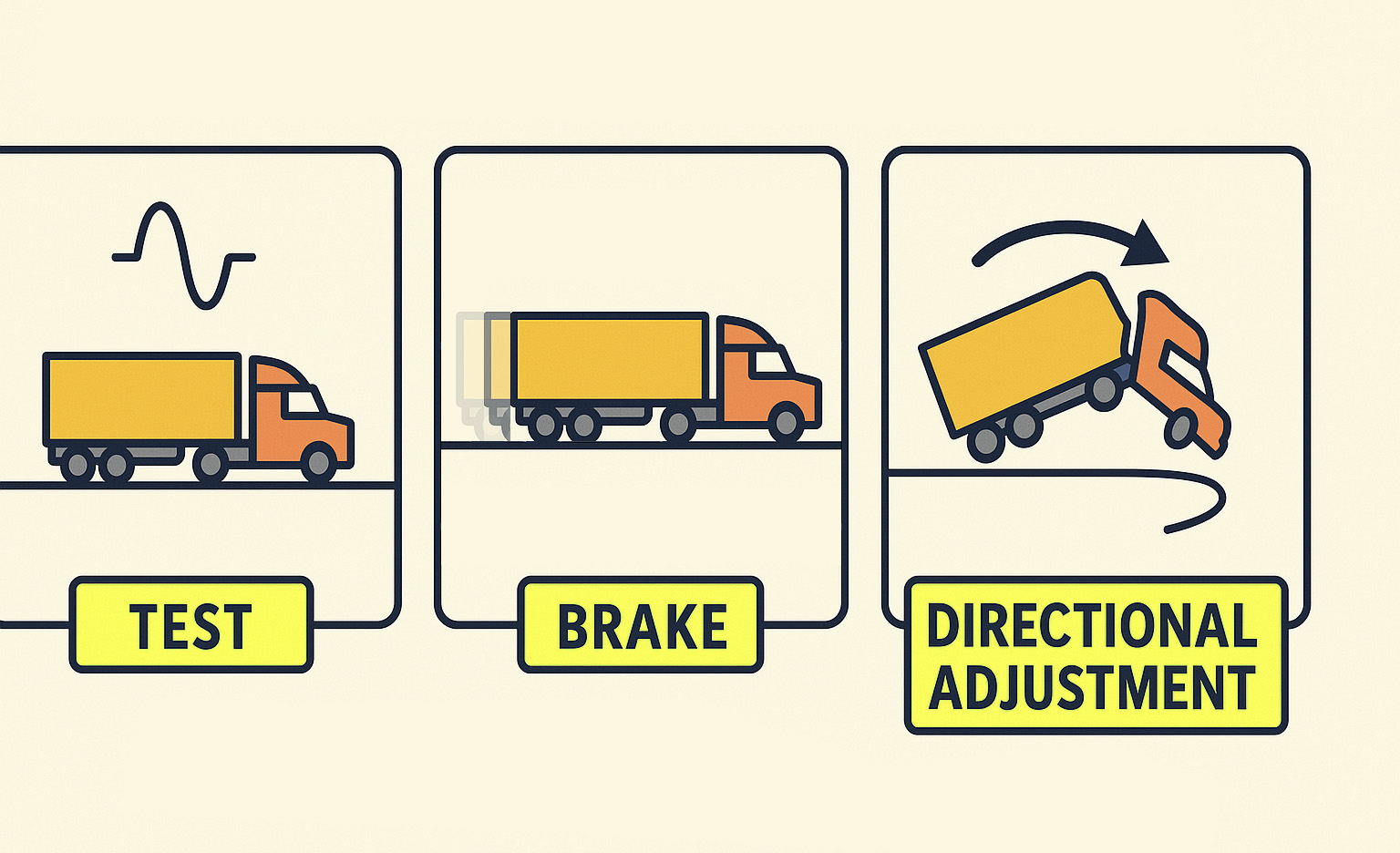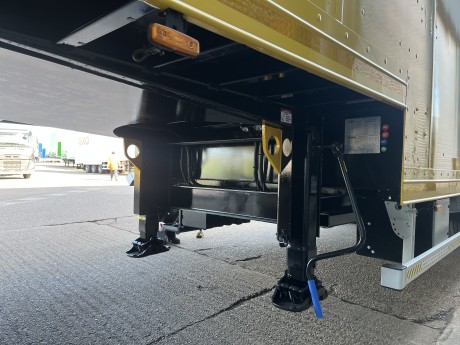These are common trailer rollover prevention systems developed by different manufacturers:
- RSS – Roll Stability Support (ZF / WABCO)
- RSP – Roll Stability Program (Knorr-Bremse)
- RSC – Roll Stability Control (Haldex)
Despite the different names, all three are electronic safety systems fitted to trailers or tractor units that help reduce the risk of rollovers. Their core purpose is the same: to detect when a vehicle is in danger of tipping and intervene automatically to prevent it.
Why do trailers roll over?
Rollover accidents happen when a vehicle’s centre of gravity shifts too far to one side – usually due to sharp cornering, sudden manoeuvres, or when travelling too fast around bends or roundabouts. Tall loads, liquid cargo, or uneven weight distribution make the risk even worse.
Each trailer has a pre-determined centre of gravity (COG) that’s used during design and testing, including axle positioning and wheel track calculations, particularly in line with ECE R111. If that COG is raised too high — for example, if a dense, heavy load is placed higher up rather than evenly distributed — the trailer becomes far more likely to roll over, even at lower speeds.
In these moments, the lateral forces acting on the vehicle can overcome its balance, causing the trailer or whole rig to tip. That’s where RSS, RSP or RSC comes in.
What does RSS, RSP or RSC actually do?
Important: For these systems to function correctly, the trailer must be connected to the tractor unit via a valid ISO 7638 (EBS/ABS) coupling. This electrical and CAN data connection transfers power and information. Without it, the system will not operate.
Rollover typically becomes a serious risk at around 0.4G of lateral acceleration (as outlined in ECE R111). Stability systems are designed to act before that point is reached.
These systems continuously monitor driving conditions using sensors. When they detect that the vehicle is approaching a rollover threshold, they automatically apply the brakes to reduce speed and stabilise the tractor/trailer combination. This happens in a split second and doesn’t require any driver input.
These systems are now mandated by UNECE Regulation 13, and while different manufacturers use different names, the underlying functionality is broadly the same.
- Work in conjunction with trailer EBS (Electronic Braking Systems)
- Use lateral accelerometers, wheel speed sensors, and sometimes load sensors
- Operate automatically with no driver input required
- May also integrate into tractor systems depending on configuration
WABCO RSS Logic
Stage 1: Early Warning and Preconditioning
- When the lateral G-force reaches around 0.2G, the system initiates a low-level braking action (2 BAR air pressure).
- This stage is not primarily intended to slow the vehicle significantly. Instead, it serves to test and prepare the system for a possible escalation.
- Once the brake signal is sent, the ECU checks that all systems are responding correctly and verifies that all wheels remain in contact with the road surface.
- It also monitors wheel speed sensors for differences between sides (a sign the vehicle may be turning).
Stage 2: Active Braking and Warning
- If the G-force increases to 0.3G or more, the system applies the brakes automatically.
- The braking at this stage is significantly stronger than in Stage 1 and is designed to slow the vehicle quickly enough to bring it back within a safe range.
- At this point, the ECU also sends a CAN message to the tractor unit to signal a rollover risk.
Stage 3: Directional Adjustment and Controlled Deceleration
- If the left and right wheel speeds differ, the system recognises that the trailer is turning.
- It applies more proportional braking force to the inside wheels of the bend to help maintain the desired direction.
- This asymmetric braking helps to prevent the trailer being unintentionally pulled straight, keeping the combination stable.
- The system continues in a controlled loop until the trailer is back to a safe speed.
Knorr-Bremse RSP Logic
While Knorr-Bremse’s RSP system achieves the same goals as WABCO’s RSS, its control logic and stage order are slightly different:
Test Pulse
When lateral acceleration exceeds a predefined threshold at a normal rate, a test pulse is triggered. This applies a low-pressure brake signal to assess whether the inside wheels react (i.e., decelerate). If they do, it indicates a high rollover risk and the system moves to Step 2. If not, no action is taken and the system adapts its threshold through a learning process.
Step 2: Full Brake Intervention
If the test pulse confirms risk, a full brake application is made — usually targeting the outside wheels of the bend — to quickly reduce lateral acceleration.
Step 1: Immediate Intervention
If lateral acceleration increases rapidly (as in an evasive manoeuvre), Knorr-Bremse bypasses the test pulse entirely and applies immediate braking. This early action prevents rollover in cases where delay could be critical.
This architecture provides a flexible and responsive system that adapts based on how quickly instability develops.
Are these systems standard?
Yes – roll stability systems are now a mandatory requirement under UNECE Regulation 13 for new trailers and applicable vehicles. While earlier generations of trailers may not have had them fitted as standard, modern vehicles must be equipped with these systems. Retrofitting may still be an option for older units, depending on the braking system in place (EBS is required).
Driver and Fleet Considerations
- If RSS, RSP or RSC activates during driving, it may feel like the trailer is being pulled back or may show up in ODR (on-demand reporting) or telematics data. Each activation can cause additional and potentially significant wear to brake linings and introduce extra stresses on the braking system and suspension.
- Driver behaviour should be reviewed. A more measured approach to cornering could prevent RSS/RSP activation entirely. Remember, if an activation occurs, it should be treated as a near-miss. Without the system in place, a rollover may have occurred.
- Consider load placement. Was the load positioned low and centrally, ideally between the wheel bogies? Were heavy items kept at the bottom to avoid a top-heavy configuration? Was the load secured properly with no opportunity to shift?
- Check for trailer defects. Issues like faulty ABS sensors or suspension problems may be masked by the RSS intervention. It’s important not to assume the system will always compensate for mechanical faults.
Final thoughts
Rollover prevention systems like RSS, RSP and RSC don’t stop a vehicle from tipping if the laws of physics are well and truly broken – but they can and do prevent a lot of close calls. For operators, they’re an invisible safety net that steps in when it matters most.
Understanding how these systems work helps drivers and fleet managers make more informed decisions about vehicle spec, driver training, safety priorities, and what to expect on the road.
We’d love to hear from you – get in touch today!



